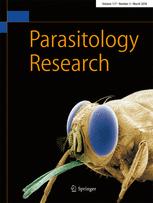View Item
- xmlui.general.dspace_homeCentros Regionales y EEAsCentro Regional Buenos Aires SurEEA BalcarceArtículos científicosxmlui.ArtifactBrowser.ItemViewer.trail
- DSpace Home
- Centros Regionales y EEAs
- Centro Regional Buenos Aires Sur
- EEA Balcarce
- Artículos científicos
- View Item
Immune response to Neospora caninum live tachyzoites in prepubertal female calves
Abstract
The aim of the present study was to characterize the specific immune response in prepubertal female calves inoculated with Neospora caninum. Forty-eight N. caninum-seronegative 6-month-old Angus female calves were randomly allocated into two groups: group A calves were inoculated subcutaneously (sc) with 1 × 106 tachyzoites of the low virulence NC-Argentina LP1 isolate in sterile phosphate-buffered saline (PBS); group B calves were mock inoculated sc with
[ver mas...]
The aim of the present study was to characterize the specific immune response in prepubertal female calves inoculated with Neospora caninum. Forty-eight N. caninum-seronegative 6-month-old Angus female calves were randomly allocated into two groups: group A calves were inoculated subcutaneously (sc) with 1 × 106 tachyzoites of the low virulence NC-Argentina LP1 isolate in sterile phosphate-buffered saline (PBS); group B calves were mock inoculated sc with sterile PBS. Calves from group A developed a specific immune response characterized by the production of IgG antibodies and the expression of IFN-γ and TNF-α cytokines. Animals did not present any febrile reaction or reactions at the site of inoculation. Although chronic N. caninum infection was developed in 50% of calves of group A after inoculation, according to the presence of antibodies against rNc-SAG4, antigen characteristic of bradyzoites, N. caninum antibodies dropped below the cut-off of ELISA from day 210 post-inoculation onwards. Future trials using the same group of inoculated animals will allow the characterization of the evolution of the immune response during pregnancy and to determine whether the immunization with the local isolate is able to prevent congenital transmission and to protect against heterologous challenges.
[Cerrar]

Author
Hecker, Yanina;
Regidor-Cerrillo, Javier;
Fiorani, Franco;
Horcajo, Pilar;
Soria, Ivana;
Gual, Ignacio;
Torioni, Susana Marta;
Campero, Lucia;
Echaide, Ignacio Eduardo;
Alvarez-García, Gema;
Ortega-Mora, Luis;
Zamorano, Patricia Ines;
Venturini, María Clara;
Odeon, Anselmo Carlos;
Canton, German Jose;
Moore, Prando Dadin;
Fuente
Parasitollogy Research 18 (10) : 2945-2955. (October 2019)
Date
2019-09-04
Editorial
Springer Berlin
ISSN
0932-0113 (Print)
1432-1955 (Online)
1432-1955 (Online)
Formato
pdf
Tipo de documento
artículo
Palabras Claves
Derechos de acceso
Restringido
 Excepto donde se diga explicitamente, este item se publica bajo la siguiente descripción: Creative Commons Attribution-NonCommercial-ShareAlike 2.5 Unported (CC BY-NC-SA 2.5)
Excepto donde se diga explicitamente, este item se publica bajo la siguiente descripción: Creative Commons Attribution-NonCommercial-ShareAlike 2.5 Unported (CC BY-NC-SA 2.5)

